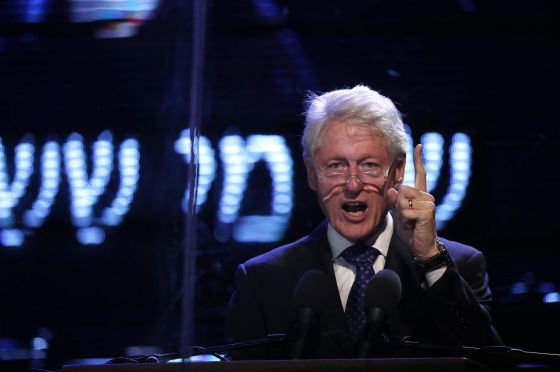Miles de israelíes homenajean a Rabin a los 20 años de su asesinato
El expresidente Clinton participa en el homenaje en el lugar donde un judío ultra lo mató
Beatriz Lecumberri
Jerusalén
31 OCT 2015

Bill Clinton participa en el homenaje a Rabin en Tel Aviv. / T. COEX (AFP)
Miles de personas se han dado cita este sábado en Tel Aviv para recordar al ex primer ministro Isaac Rabin, asesinado el 4 de noviembre de 1995 por un extremista judío. El acto, que conmemora el 20º aniversario según el calendario judío, se produce en un momento en que la violencia y el extremismo vuelven a castigar a israelíes y palestinos.
Grupos
pacifistas, movimientos de jóvenes, políticos, artistas y ONGs
participaron en este acto, en el que también estuvieron presentes el
presidente de Israel, Reuven Rivlin, y el exmandatario estadounidense
Bill Clinton, quien apadrinó los acuerdos de paz de Oslo de 1993 entre
Israel, representado por Rabin, y los palestinos, encabezados por el
fallecido Yasir Arafat.
"El siguiente paso en la historia de Israel será decidir si Rabin
tenía razón, si ustedes deben compartir su futuro con sus vecinos y si
el riesgo que se corre persiguiendo la paz no es tan grande como el
riesgo que supone alejarse de ella. Rezamos para que tomen la buena
decisión”, dijo Clinton en su discurso ante una multitud emocionada que
según los organizadores rozaba las 100.000 personas aunque medios
locales apuntaban que en la plaza Rabin había entre 40.000 y 50.000
personas.
En un discurso grabado y difundido durante la concentración, el
presidente estadounidense Barack Obama también instó a israelíes y
palestinos a “comprometerse y correr riesgos para lograr la única
solución real: dos Estados para dos pueblos”.
“Veinte años han pasado y aun estamos demasiado ocupados con las
heridas del pasado en lugar de construir el futuro. No tenemos que tener
miedo, la democracia israelí es suficientemente fuerte. A aquellos que
nos amenazan quiero decirles hoy: no les tenemos miedo”, dijo Rivlin
durante el acto, en el que no estuvo presente ningún miembro del
gobierno del primer ministro Benjamin Netanyahu.
Yigal Amir, el asesino de Rabin explicó claramente que su intención
era sabotear cualquier acuerdo de paz entre israelíes y palestinos.
Veinte años después, las negociaciones no han dado apenas frutos y están
congeladas desde hace año y medio. La creación del Estado palestino,
que tras Oslo parecía tocarse con los dedos, no logra concretarse.
Más violencia en Cisjordania
La ola de violencia que castiga desde principios de octubre a
israelíes y palestinos no da tregua. Este sábado el ejército israelí
mató a un palestino de 17 años en un retén de Cisjordania cuando, según
fuentes militares, intentó apuñalar a un soldado.
Al menos 66 palestinos, la mitad de ellos agresores o presuntos
agresores, y nueve israelíes han muerto violentamente en las últimas
semanas. Este sábado cerca de Belén era enterrado un bebé palestino de
ocho meses fallecido el viernes asfixiado, según las autoridades
palestinas, por los gases lacrimógenos lanzados por el Ejército israelí
cerca de su domicilio.
La tensión y los controles siguen siendo palpables en ciudades como
Jerusalén, escenario de numerosos ataques y de enfrentamientos.
Las imágenes y los videos de presuntos abusos de las fuerzas de
seguridad israelíes recorren las redes sociales y avivan la cólera
palestina. Este sábado, la policía israelí informó de que suspendía a un
agente que amenazó por megafonía a los vecinos del campo de refugiados
palestino de Aida, cerca de Belén, con "matar a todos" si los vecinos
seguían lanzando piedras. "Somos el Ejército de ocupación (…) Si tiran
una piedra les vamos a lanzar gas hasta que mueran. Los niños, los
jóvenes, los ancianos. Moriréis todos”, dijo el oficial en árabe.
La violencia se extiende también a la franja de Gaza, escenario de
manifestaciones antiisraelíes diarias, y a puntos de Cisjordania como la
ciudad palestina de Hebrón, donde la tensión y las restricciones se han
agravado.
Esta localidad del sur de Cisjordania es desde hace años un
microcosmos que resume perfectamente el desgarrado conflicto
israelo-palestino. En su centro histórico, que alberga la Tumba de los
Patriarcas, venerada por judíos, musulmanes y cristianos, conviven unos
35.000 palestinos y alrededor de 800 colonos israelíes, protegidos por
otros tantos militares y policías, según datos de la ONG israelí
B’tselem.
En los últimos días el Ejército israelí ha matado a varios palestinos
en la región de Hebrón. Según fuentes militares, la mayoría de ellos
intentaron atacar a israelíes, una versión que ha sido puesta en
entredicho por responsables locales palestinos. Cinco de los palestinos
muertos fueron enterrados este sábado en medio de una gran tensión y de
nuevos enfrentamientos. Al menos doce palestinos han resultado heridos
en los disturbios, según fuentes médicas locales.
Los 200.000 habitantes de Hebrón, que desde hace años deben atravesar
retenes militares y controles para ir a trabajar o estudiar, son objeto
desde hace varios días de una vigilancia más exhaustiva. El ejército
israelí ha instalado barreras en numerosos puntos de la ciudad, sobre
todo en los barrios colindantes con algunos asentamientos israelíes, y
prohíbe la entrada de palestinos que no residan en la zona.
Por otro lado, la prensa local israelí, citando a medios digitales de
la oposición siria, afirmó este sábado que la aviación israelí
bombardeó el viernes por la noche dos posiciones de la milicia chií
libanesa Hezbulá y del régimen de Bachar el Asad, cerca de la frontera
con Líbano.
Si estas informaciones se confirman sería el primer bombardeo israelí
en suelo sirio desde que Rusia inició su campaña aérea de bombardeos
contra posiciones rebeldes a finales de septiembre.
Link http://internacional.elpais.com/internacional/2015/10/31/actualidad/1446316234_035917.html

